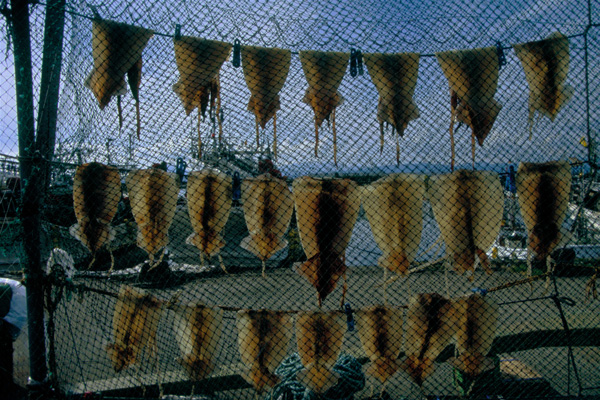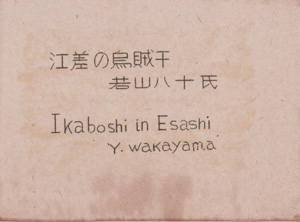About This Print
One of twelve prints from the series Picture Notes on Native Customs of Japan depicting folk rituals from different parts of Japan. It is suggested by Lawrence Smith that the prints paid homage to the Folk Art (mingei) movement that Onchi Kōshirō (1891-1955), who played an unspecified role in issuing this series, was sympathetic to.1In the Artist's Words
| "Ikaboshi in Esashi" - Esashi in Hokkaido island was famous for its folk songs - Oiwake. It was very prosperous during the Edo era but it became obsolete during the Meiji era. Because of its long history, it retained its unique customs. Squid drying was one of them.- Wakayama Yasōji |
1 JapanesePrints During the Allied Occupation 1945-1952, Lawrence Smith, BritishMuseum Press, 2003, p. 26.
Squid drying on Hokkaido
About the Series Picture Notes on Native Customs of Japan
For details on this series see Iwato Kagura Play from the series Picture Notes on Native Customs of Japan.
Print Details
| IHL Catalog | #773 |
| Title/Description | Ikaboshi in Esashi 江差の烏賊干 |
| Series | Picture Notes on Native Customs of Japan 日本民俗図譜 Nihon Minzoku Zufu |
| Artist | Wakayama Yasōji (1903-1983) |
| Signature | |
| Seal | artist's name in lower portion of right margin |
| Publication Date | 1946 |
| Publisher | Takamizawa Mokuhan Honsha for Fugaku Shuppan-sha. |
| Impression | excellent |
| Colors | excellent |
| Condition | excellent |
| Miscellaneous | Label attached to verso of folder |
| Genre | sosaku hanga (creative prints) |
| Format | |
| H x W Paper | 8 x 10 3/4 in. (20.3 x 27.3 cm ) |
| H x W Image | 7 3/8 x 9 5/8 in. (18.7 x 24.4 cm) |
| Collections This Print | British Museum 1980,1227,0.19.4; National Library of Australia 4653042 |




